fuel pressure Acura ZDX 2012 Owner's Manual
[x] Cancel search | Manufacturer: ACURA, Model Year: 2012, Model line: ZDX, Model: Acura ZDX 2012Pages: 370, PDF Size: 10.06 MB
Page 10 of 370
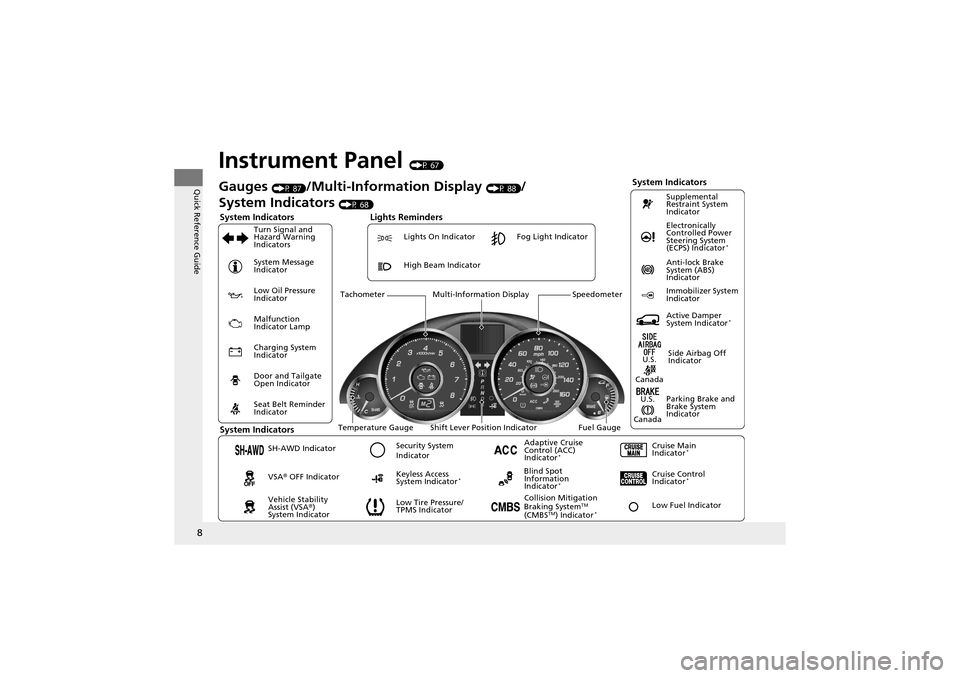
8
Quick Reference Guide
Instrument Panel (P 67)
System Indicators
Malfunction
Indicator Lamp Low Oil Pressure
Indicator
Charging System
IndicatorAnti-lock Brake
System (ABS)
Indicator
Vehicle Stability
Assist (VSA ®)
System Indicator VSA ® OFF Indicator
Low Tire Pressure/
TPMS Indicator Electronically
Controlled Power
Steering System
(ECPS) Indicator
*
Lights Reminders
Lights On Indicator
High Beam Indicator
Fog Light Indicator
Immobilizer System
Indicator
Seat Belt Reminder
Indicator
System Indicators
Cruise Control
Indicator*
System Message
Indicator
Parking Brake and
Brake System
Indicator Supplemental
Restraint System
Indicator
Side Airbag Off
Indicator
Door and Tailgate
Open Indicator
Cruise Main
Indicator
*
TachometerSpeedometer
Fuel Gauge
Security System
Indicator Shift Lever Position Indicator
Low Fuel Indicator
Gauges (P 87)/Multi-Information Display (P 88)/
System Indicators
(P 68)
Turn Signal and
Hazard Warning
Indicators
Temperature Gauge
SH-AWD Indicator
Keyless Access
System Indicator
*
Active Damper
System Indicator*
Blind Spot
Information
Indicator
*
Collision Mitigation
Braking SystemTM
(CMBSTM) Indicator*
Adaptive Cruise
Control (ACC)
Indicator
*
System Indicators
Multi-Information Display
U.S.
Canada Canada
U.S.
Page 16 of 370
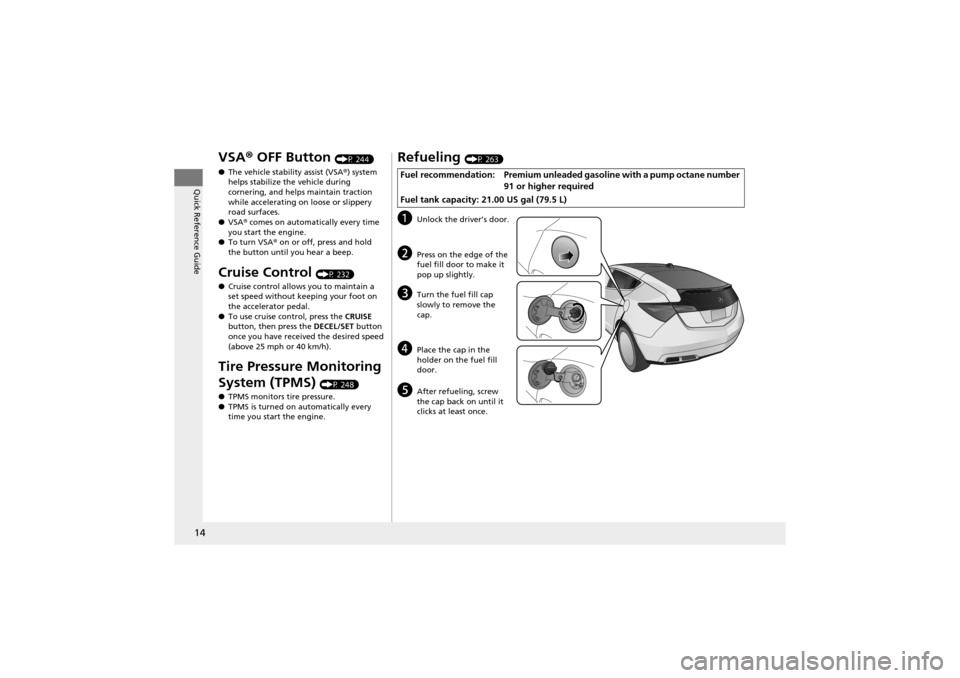
14
Quick Reference Guide
VSA® OFF Button (P 244)
● The vehicle stabil ity assist (VSA®) system
helps stabilize the vehicle during
cornering, and helps maintain traction
while accelerating on loose or slippery
road surfaces.
● VSA ® comes on automati cally every time
you start the engine.
● To turn VSA ® on or off, press and hold
the button until you hear a beep.
Cruise Control (P 232)
● Cruise control allows you to maintain a
set speed without keeping your foot on
the accelerator pedal.
● To use cruise control, press the CRUISE
button, then press the DECEL/SET button
once you have received the desired speed
(above 25 mph or 40 km/h).
Tire Pressure Monitoring
System (TPMS)
(P 248)
● TPMS monitors tire pressure.
● TPMS is turned on automatically every
time you start the engine.
Refueling (P 263)
aUnlock the driver’s door.
bPress on the edge of the
fuel fill door to make it
pop up slightly.
cTurn the fuel fill cap
slowly to remove the
cap.
dPlace the cap in the
holder on the fuel fill
door.
eAfter refueling, screw
the cap back on until it
clicks at least once.
Fuel recommendation: Premium unleaded gasoline with a pump octane number
91 or higher required
Fuel tank capacity: 21.00 US gal (79.5 L)
Page 211 of 370

209
Driving
This chapter discusses driving, refueling, an d information on items such as accessories.
Before Driving
Driving Preparation .......................... 210
Maximum Load Limit........................ 213
Towing a Trailer Towing Preparation ..... ..................... 215
Driving Safely with a Trailer .............. 218
Towing Your Vehicle ........................ 219
Off-Highway Driving Guidelines General Information ......................... 220
Important Safety Prec autions............ 220
Avoiding Trouble ......... .................... 221
When Driving Starting the Engine .......................... 223
Precautions While Driving ................ 226
Automatic Transmission ................... 227
Shifting ............................................ 228
Cruise Control
*............................... 232
ACC (Adaptive Cruise Control)*....... 235VSA® (Vehicle Stability Assist), aka ESC
(Electronic Stability Control), System ...... 243
SH-AWD ® (Super Handling-All Wheel
DriveTM) .......................................... 245
BSI (Blind Spot Information)*........... 246TPMS (Tire Pressure Monitoring System) .. 248IDS (Integrated Dynamics System)*... 252 Braking
Brake System ................................... 253
ABS (Anti-lock Brake System) ........... 255
Brake Assist System ......................... 256
CMBS
TM (Collision Mitigation Braking
SystemTM)*..................................... 257
Parking Your Vehicle ........................ 261
Rearview Camera
*............................ 262
Refueling ........................................... 263
Fuel Economy .................................... 266
Accessories and Modifications ........ 267
* Not available on all models
Page 252 of 370
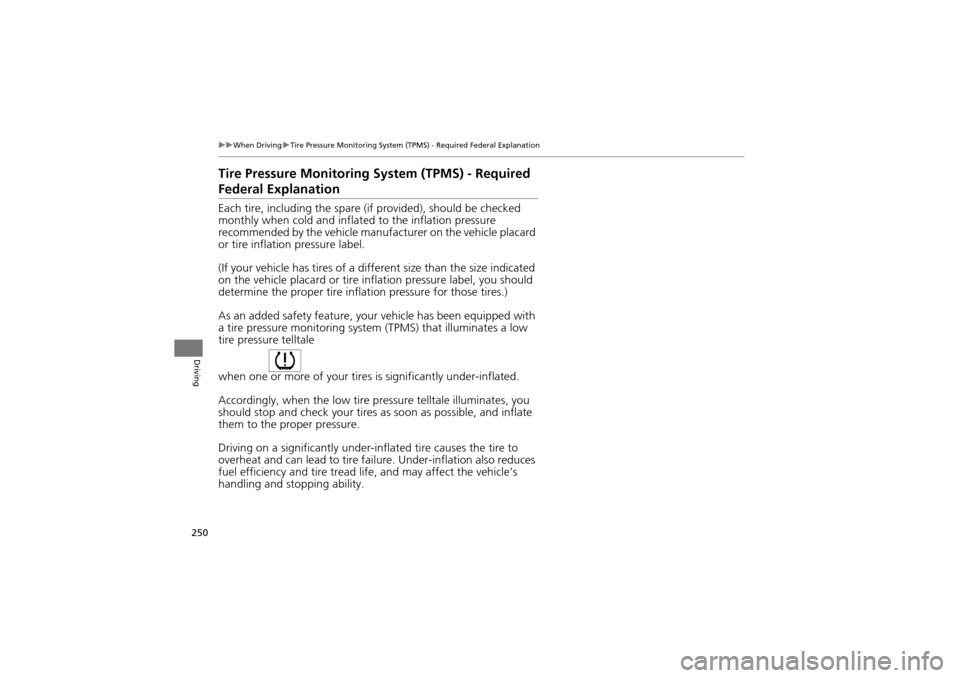
250
uuWhen Driving uTire Pressure Monitoring System (TPM S) - Required Federal Explanation
Driving
Tire Pressure Monitoring System (TPMS) - Required
Federal Explanation
Each tire, including the spare (if provided), should be checked
monthly when cold and inflated to the inflation pressure
recommended by the vehicle manufacturer on the vehicle placard
or tire inflation pressure label.
(If your vehicle has tires of a diffe rent size than the size indicated
on the vehicle placard or tire inflation pressure label, you should
determine the proper tire inflation pressure for those tires.)
As an added safety feature, your vehicle has been equipped with
a tire pressure monitoring system (TPMS) that illuminates a low
tire pressure telltale
when one or more of your tires is significantly under-inflated.
Accordingly, when the low tire pr essure telltale illuminates, you
should stop and check your tires as soon as possible, and inflate
them to the proper pressure.
Driving on a significantly under-inflated tire causes the tire to
overheat and can lead to tire fail ure. Under-inflation also reduces
fuel efficiency and tire tread life, and may affect the vehicle’s
handling and stopping ability.
Page 268 of 370
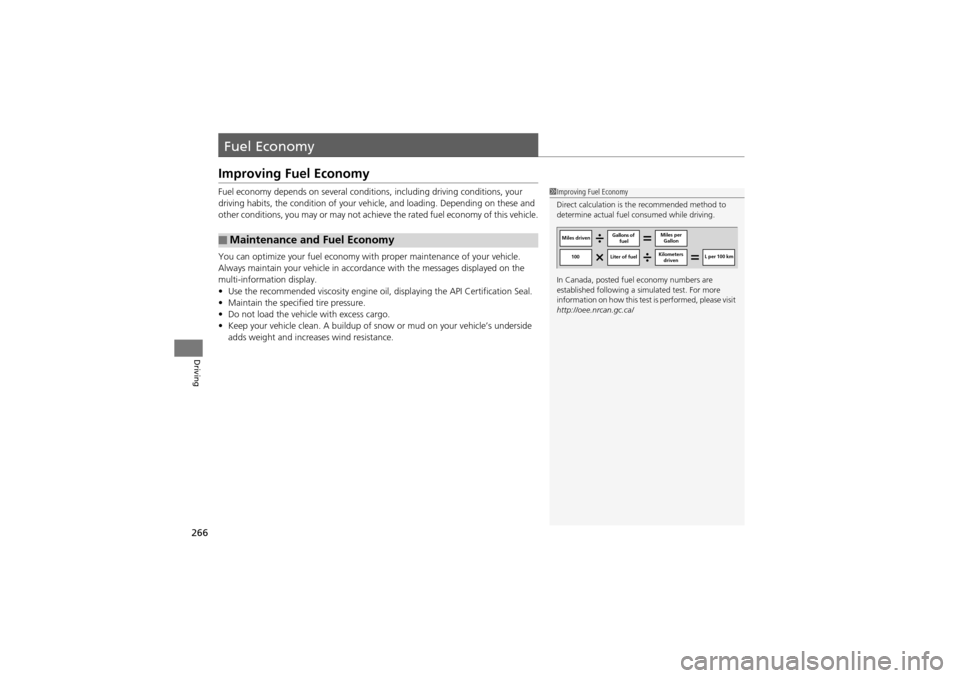
266
Driving
Fuel Economy
Improving Fuel Economy
Fuel economy depends on several conditions, including driving conditions, your
driving habits, the condition of your vehicle, and loading. Depending on these and
other conditions, you may or may not achieve the rated fuel economy of this vehicle.
You can optimize your fuel economy with proper maintenance of your vehicle.
Always maintain your vehicle in accordance with the messages displayed on the
multi-information display.
• Use the recommended viscosity engine oil, displaying the API Certification Seal.
• Maintain the specified tire pressure.
• Do not load the vehicle with excess cargo.
• Keep your vehicle clean. A buildup of snow or mud on your vehicle’s underside
adds weight and increases wind resistance.
■Maintenance and Fuel Economy
1Improving Fuel Economy
Direct calculation is th e recommended method to
determine actual fuel consumed while driving.
In Canada, posted fuel economy numbers are
established following a si mulated test. For more
information on how this test is performed, please visit
http://oee.nrcan.gc.ca/
Miles driven Gallons of
fuel Miles per
Gallon
100 Liter of fuel Kilometers
driven L per 100 km
Page 272 of 370
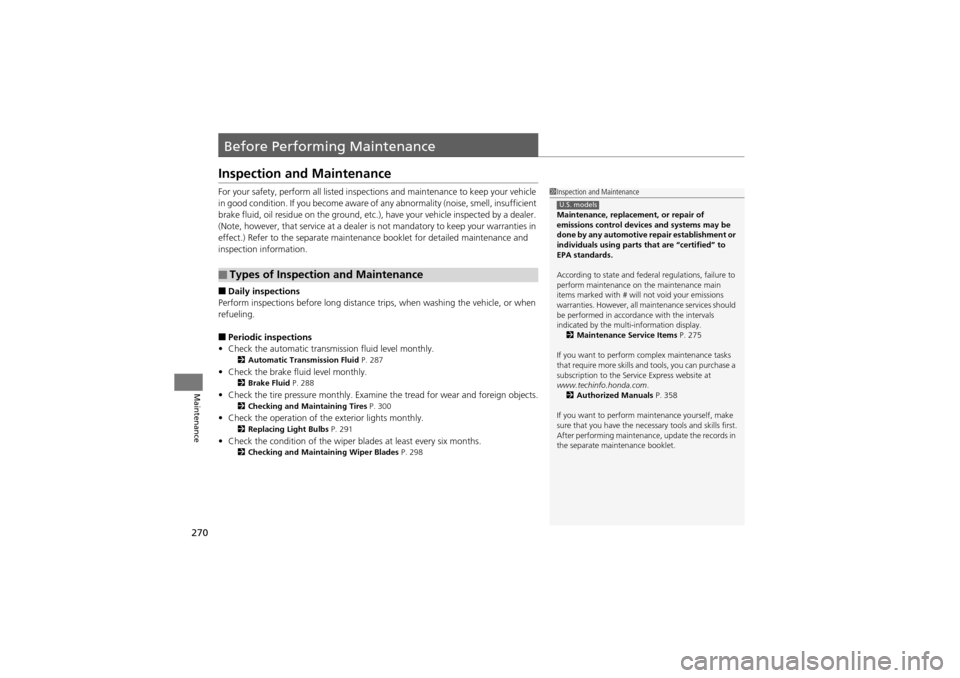
270
Maintenance
Before Performing Maintenance
Inspection and Maintenance
For your safety, perform all listed inspections and maintenance to keep your vehicle
in good condition. If you become aware of any abnormality (noise, smell, insufficient
brake fluid, oil residue on the ground, etc.), have your vehicle inspected by a dealer.
(Note, however, that service at a dealer is not mandatory to keep your warranties in
effect.) Refer to the separate maintenanc e booklet for detailed maintenance and
inspection information.
■Daily inspections
Perform inspections before long distance trips, when washing the vehicle, or when
refueling.
■Periodic inspections
• Check the automatic transmi ssion fluid level monthly.
2Automatic Tran smission Fluid P. 287
•Check the brake fluid level monthly.2 Brake Fluid P. 288
•Check the tire pressure monthly. Examin e the tread for wear and foreign objects.2Checking and Maintaining Tires P. 300
•Check the operation of th e exterior lights monthly.2Replacing Light Bulbs P. 291
•Check the condition of the wiper bl ades at least every six months.2Checking and Maintaining Wiper Blades P. 298
■Types of Inspection and Maintenance
1Inspection and Maintenance
Maintenance, replacement, or repair of
emissions contro l devices and systems may be
done by any automotive repair establishment or
individuals using parts that are “certified” to
EPA standards.
According to state and federal regulations, failure to
perform maintenance on the maintenance main
items marked with # will not void your emissions
warranties. However, all maintenance services should
be performed in accordance with the intervals
indicated by the multi-information display.
2 Maintenance Service Items P. 275
If you want to perform complex maintenance tasks
that require more skills an d tools, you can purchase a
subscription to the Serv ice Express website at
www.techinfo.honda.com .
2 Authorized Manuals P. 358
If you want to perform ma intenance yourself, make
sure that you have the nece ssary tools and skills first.
After performing ma intenance, update the records in
the separate maintenance booklet.
U.S. models
Page 302 of 370

300
Maintenance
Checking and Maintaining Tires
Checking Tires
To safely operate your vehicle, your tires must be of the proper type and size, in
good condition with adequate tread, and properly inflated.
■Inflation guidelines
Properly inflated tires provide the best comb ination of handling, tread life, and comfort.
Refer to the driver’s doorjamb label or spec ification’s page for the specified pressure.
Underinflated tires wear unevenly, adversel y affect handling and fuel economy, and
are more likely to fail from overheating.
Overinflated tires make your vehicle ride ha rshly, are more prone to road hazards,
and wear unevenly.
Every day before you drive, look at each of the tires. If one looks lower than the
others, check the pressu re with a tire gauge.
At least once a month or before long trip s, use a gauge to measure the pressure in
all tires, including the spare. Even tires in good condition can lose 1 to 2 psi (10 to
20 kPa, 0.1 to 0.2 kgf/cm
2) per month.
■Inspection guidelines
Every time you check inflation, also examine the tires and valve stems.
Look for:
• Bumps or bulges on the side or in the tread. Replace the tire if you find any cuts,
splits, or cracks in the si de of the tire. Replace it if you see fabric or cord.
• Remove any foreign objects and inspect for air leaks.
• Uneven tread wear. Have a deal er check the wheel alignment.
• Excessive tread wear.
2 Wear Indicators P. 305
•Cracks or other damage around valve stem.
1Checking Tires
Measure the air pressure when tires are cold. This means
the vehicle has been parked for at least three hours, or
driven less than 1 mile (1.6 km). If necessary, add or
release air until the specified pressure is reached.
If checked when hot, tire pressure can be as much as
4–6 psi (30–40 kPa, 0.3–0.4 kgf/cm
2) higher than if
checked when cold.
Have a dealer check the tires if you feel a consistent
vibration while driving. New tires and any that have
been removed and reinstalled should be properly
balanced.
High speed driving
We recommend that you do not drive faster than the
posted speed limits and conditions allow. If you drive
at sustained high speeds (over 99 mph or 160 km/h),
adjust the cold tire pressures as shown below to
avoid excessive heat build up and sudden tire failure.
3WARNING
Using tires that are excessively worn or
improperly inflated can cause a crash in
which you can be seriously hurt or killed.
Follow all instructions in this owner’s
manual regarding tire inflation and
maintenance.
Tire SizeP255/50R19 103H
Pressure (front) 33 psi (227 kPa, 2.3 kgf/cm2)
Page 319 of 370
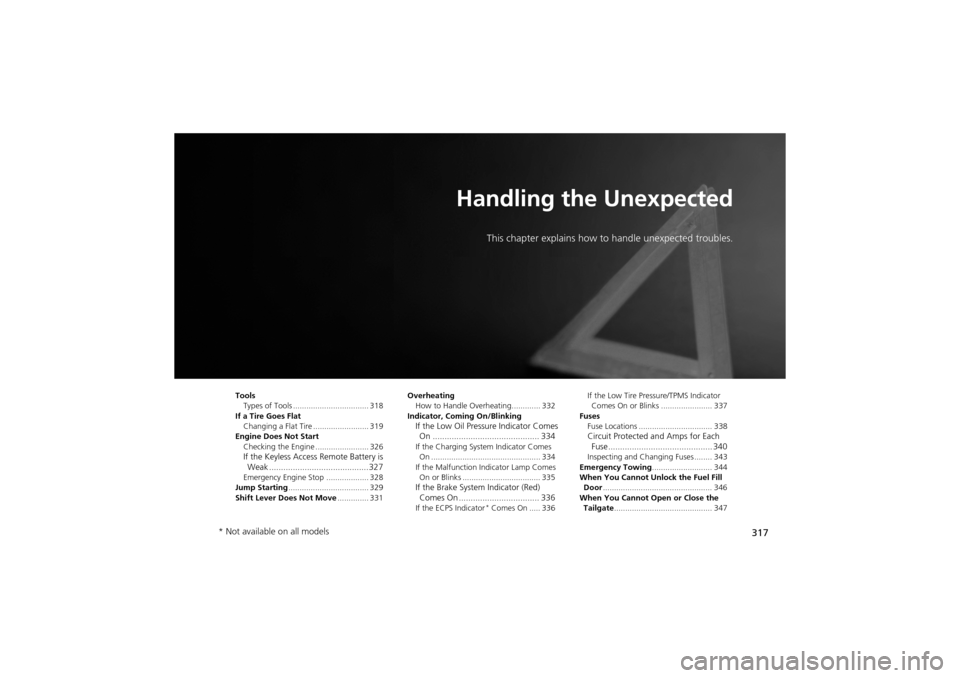
317
Handling the Unexpected
This chapter explains how to handle unexpected troubles.
Tools
Types of Tools .................................. 318
If a Tire Goes Flat Changing a Flat Tire ......................... 319
Engine Does Not Start
Checking the Engine ........................ 326
If the Keyless Access Remote Battery is Weak ..........................................327
Emergency Engine Stop ................... 328
Jump Starting .................................... 329
Shift Lever Do es Not Move.............. 331 Overheating
How to Handle Overheating............. 332
Indicator, Coming On/Blinking
If the Low Oil Pressure Indicator Comes On ............................................. 334
If the Charging System Indicator Comes
On ................................................. 334
If the Malfunction Indicator Lamp Comes On or Blinks ................................... 335
If the Brake System Indicator (Red) Comes On .................................. 336
If the ECPS Indicator* Comes On ..... 336 If the Low Tire Pres
sure/TPMS Indicator
Comes On or Blinks ....................... 337
Fuses Fuse Locations ................................. 338
Circuit Protected and Amps for Each Fuse............................................ 340
Inspecting and Changing Fuses ........ 343
Emergency Towing ........................... 344
When You Cannot Unlock the Fuel Fill Door ................................................. 346
When You Cannot Open or Close the Tailgate ............................................ 347
* Not available on all models
Page 352 of 370

350
Information
Specifications
■Vehicle Specifications
*1: The GCWR must be reduced 2 percent for every 1,000 feet (305
meters) of elevation.
■Engine Specifications
■ Fuel
■ Battery
ModelAcura ZDX
No. of Passengers:
Front 2
Rear 3
Total 5
Weights:Gross Vehicle
Weight Rating 5,534 lbs (2,510 kg)
Gross Axle Weight
Rating (Front)2,921 lbs (1,325 kg)Gross Axle Weight
Rating (Rear)2,679 lbs (1,215 kg)
Gross Combined
Weight
*1
Rating (GCWR) 6,593 lbs (2,990 kg)
Air Conditioning:Refrigerant Type HFC-134a (R-134a)Charge Quantity16.9 – 18.7 oz (480 – 530 g)Lubricant TypeND-OIL 8
Displacement223.5 cu-in (3,664 cm3)
Spark Plugs NGK ILZKR7B-11S
DENSO SXU22HCR11S
Fuel:
TypePremium unleaded gasoline, Pump octane
number of 91 or higher
Fuel Tank Capacity 21.00 US gal (79.5 ℓ)
Capacity/Type55AH(5)/65AH(20)
■ Washer Fluid
■ Light Bulbs
■ Brake Fluid
■ Transmission FluidTank Capacity5.2 US qt (4.9 ℓ)
Headlights (High/Low Beam)35W (D2S)
Daytime Running Lights 60W (HB3)
Fog Lights55W (H11)
Front Turn Signal/Parking Lights 28/8W (Amber)
Front Side Marker Lights5W
Side Turn Signal Lights
(on Door Mirrors) LED
Rear Turn Signal Lights21W
Rear Side Marker Lights 3 CP
Back-Up Lights21W
Stop/Taillights 21/5W
High-Mount Brake LightLED
Rear License Plate Lights 5W
Cargo Area Lights8W
Interior Lights
Front and Rear Map
LightsLED
Vanity Mirror Lights2WDoor Courtesy Lights3.4WConsole Compartment Light1.4WGlove Box Light1.4WFoot LightLEDDoor Inner Handle Light*LED
SpecifiedHonda Heavy Duty Brake Fluid DOT 3
SpecifiedAcura ATF DW-1
(automatic transmission fluid)
Capacity Change 3.3 US qt (3.1 ℓ)
■ Rear Differential Fluid
■ Transfer Assembly Fluid
■ Power Steering Fluid
■ Engine Oil
■ Engine Coolant
■ TireSpecifiedAcura All Wheel Drive Fluid (DPSF)
Capacity Change 2.67 US qt (2.53 ℓ)
Specified·SAE 90 or SAE 80W-90 Viscosity Hypoid Gear Oil
·API Service Classified GL4 or GL5 only
Capacity Change 0.45 US qt (0.43 ℓ)
SpecifiedAcura Power Steering Fluid
Recommended·Acura Genuine Motor Oil 5W-20
·API Premium-grade 5W-20 detergent oil
Capacity Change 4.2 US qt (4.0 ℓ)
Change
including
filter
4.5 US qt (4.3 ℓ)
SpecifiedHonda Long-Life Antifreeze/Coolant Type2
Ratio 50/50 with distilled water
Capacity1.77 US gal (6.7 ℓ)
(change including the remaining
0.18 US gal (0.675 ℓ) in the reserve tank)
RegularSizeP255/50R19 103HPressure
psi (kPa [kgf/cm2])32 (220 [2.2])
Compact
Spare Size T165/80D17 104M
Pressure
psi (kPa [kgf/cm
2])
60 (420 [4.2])
Wheel SizeRegular19 x 8.5 JCompact Spare17 x 4 T
* Not available on all models
Page 363 of 370

Index
361
Index
A
ABS (Anti-lock Brake System).................. 255
Accessories and Modifications ................ 267
Accessory Power Sockets ......................... 157
Active Head Restraints ............................. 148
Adaptive Cruise Control (ACC) ................ 235
Additives
Coolant .................................................. 285
Engine Oil ............................................... 280
Washer ................................................... 290
Additives, Engine Oil ............................... 280
Adjusting Armrest .................................................. 150
Front Seats.............................................. 143
Head Restraints ....................................... 145
Mirrors.................................................... 141
Rear Seats ............................................... 149
Steering Wheel ....................................... 140
Temperature ............................................. 91
Air Conditioning System (Climate Control System) ...................... 163
Changing the Mode................................ 163
Defrosting the Windshield and Windows................ ....................... 164
Dust and Pollen Filter .............................. 312
Recirculation/Fresh Air Mo de................... 163
Sensor .................................................... 166
Synchronized Mode ................................ 165
Using Automatic Climate Control............ 163
Air Pressure ...................................... 301, 350 Airbags
........................................................ 35
Advanced Airbags ..................................... 41
After a Collision... ................................ 30, 39
Airbag Care ............................................... 49
Event Data Recorder .................................. 19
Front Airbags (SRS) .................................... 38
Indicator ........................................ 46, 72, 75
Passenger Airbag Off Indicator .................. 47
Sensors...................................................... 35
Side Airbag Cutoff System ......................... 44
Side Airbag Off Indicator ........................... 48
Side Airbags .............................................. 42
Side Curtain Airbags .................................. 45
AM/FM Radio ............................................ 173
Anti-lock Brak e System (ABS) .................. 255
Indicator .................................................... 71
Armrest ..................................................... 150
Audio Remote Controls ............................ 190
Audio System ............................................ 168
Adjusting the Sound ................................ 172
Auxiliary Input Jack ........ .......................... 169
Error Messages ........................................ 188
General Information ................................ 191
MP3/WMA/AAC ...................................... 183
Reactivating............................................. 170
Recommended CDs ................................. 192
Recommended Devices ............................ 194
Remote Controls ..................................... 190
Security Code .......................................... 170
Theft Protection....................................... 170
USB Adapter Cable .................................. 169 USB Flash Drives ...................................... 194
Authorized Manuals ................................ 358
Auto Door Locking/Unlocking ................. 113
Automatic Lighting .................................. 132
Automatic Transmission ........................... 227
Creeping ................................................. 227
Fluid ........................................................ 287
Kickdown ................................................ 227
Operating the Shift Lever........... 13, 229, 231
Sequential Shift Mode ............................. 230
Shift Lever Does Not Move ...................... 331
Shifting ................................................... 228
Auxiliary Input Jack .................................. 169
Average Fuel Economy .............................. 91
Average Speed ........................................... 92
B
Battery...................................................... 309
Charging System Indicato r................. 69, 334
Jump Starting .......................................... 329
Maintenance (Checking th e Battery) ........ 309
Maintenance (Replacing) ......................... 310
Belts (Seat) .................................................. 27
Beverage Holders ..................................... 156
Blind Spot Information (BSI) .................... 246
Bluetooth ® HandsFreeLink ®..................... 197
Bluetooth ®Audio ...................................... 186
Booster Seats (For Children) ...................... 63
Brake System ............................................ 253
Anti-lock Brake System (A BS)................... 255